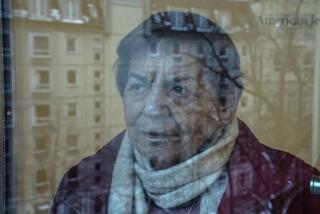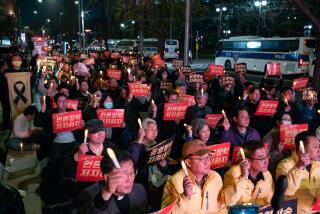City Vents Anger at Illegal Immigrants
Standing outside City Hall in the gathering dark, Norman Tarantino felt, for once, that he was lucky to live in Hazleton.
Most of his friends had moved away, over the years, convinced that the old coal city’s best days were behind it. But as of Thursday night, Tarantino said, Hazleton once again has something to be proud of: It is the most hostile environment in America for illegal immigrants.
Not 20 feet away stood Daniel Jorge, a Dominican immigrant who moved his family to Hazleton last year after 25 years in New York City. Jorge, a real estate agent, was wondering how he would break the news to his wife, who had been enchanted with the small-town friendliness she found in Hazleton, a small city in the hills 80 miles northwest of Philadelphia.
“I’m sad. I loved it here,” Jorge said. He gazed at the police officers lined up in the middle of Church Street, separating crowds of white and Latino demonstrators. “I never in my wildest dreams thought I would see this here in this city.”
By a vote of 4 to 1, Hazleton’s City Council on Thursday approved the Illegal Immigration Relief Act, which imposes severe penalties on landlords who rent space to illegal immigrants, suspends the licenses of businesses that employ them, and declares English the city’s official language.
The ordinance has brought celebrity status to Hazleton’s mayor, Louis J. Barletta, and has prompted a ripple of proposed new laws in neighboring communities.
In Florida, the communities of Avon Park and Palm Bay will vote on similar laws, as will the city of Escondido in California.
The law has also attracted a legal challenge from the Puerto Rican Legal Defense and Education Fund, which has promised to sue the city on the grounds that the ordinance unconstitutionally infringes on federal jurisdiction over immigration.
Local Latino activists warn that the vote could mark an ugly turning point in Hazleton, whose Latino minority has grown over the last decade to constitute about 30% of the population.
“What I worry is that this will be a pretext for people to allow their racist feelings to show,” said David Vaida, an attorney in Allentown, Pa., who signed the legal challenge to Barletta. “It will allow people to take that deep, dark side of them and let it come out. It will pit neighbor against neighbor, and then the city will be worse off.”
But the mood in City Hall was upbeat Thursday; white residents exploded into applause when Barletta strode into the chamber, wearing a bulletproof vest under his suit jacket. They yelled “Yes!” when a local Latino leader asked whether they would deport U.S.-born children of illegal immigrants, and cheered again when City Council President Joe Yannuzzi compared illegal immigrants to burglars.
“If I come home and find someone in my home, is he just an unwanted guest? Must I keep him there and take care of him?” he asked. “I say he has committed a crime, and should be treated like a criminal.”
Under the new law -- which is a modified version of a ballot initiative proposed in San Bernardino -- anyone seeking to rent a dwelling in the city will have to apply to the city for a residency license, and submit to an investigation of citizenship status. Landlords found renting to people without licenses will be fined $1,000 a day. Business owners found hiring, renting property to, or providing goods and services to illegal immigrants will lose their business permit for five years on a first offense and 10 years on a second.
Barletta, whose grandfather hauled coal with a horse and wagon, said Thursday’s vote was the culmination of years of complaints from constituents.
“There’s no place for me to hide in a small city,” he said. “I get it in the grocery store, I get it at the lunch counter, when I get my morning coffee, when I’m pumping gas.
“People are begging me, because we are losing the one asset that this city has to offer -- our quality of life.”
Hazleton was a shrinking and mostly white city when Latinos began to arrive.
Older residents reminisce about the miners who emerged every evening from the “40 shaft” and streamed down Diamond Avenue past the Italian bars -- Andruzzi’s, Fidule’s, Yannuzzi’s -- while the smell of meatballs hung in the air. People lived in tight ethnic clusters -- Donegal Hill for the Irish immigrants and Nanny Goat Hill for the Italians.
The city reached its peak population in the 1940s, at 38,000, then began a steady decline as mining and textiles work disappeared. The 2000 census showed a population of 23,000, with a median age of 40.
Immigrants, flowing in from New York and New Jersey, changed that trajectory, bringing the city’s population back up to between 30,000 and 31,000.
The influx brought economic growth. Donna Palermo, president of the Greater Hazleton Chamber of Commerce, said Latino immigrants built 50 to 60 new businesses in the city’s downtown and helped boost the value of some homes to $90,000 from $40,000. In an October 2005 interview with the Northeast Pennsylvania Business Journal, Barletta said the population boom had brought the city’s economy to its healthiest state in decades.
But tension surrounded the newcomers from the beginning. Elderly residents on fixed incomes struggled to catch up with the higher cost of living; a school built for 1,800 students tried to absorb 2,500.
When John Quigley, a Democratic mayor, lost his reelection bid in 1995, it was amid rumors that he had rented billboards in New York to recruit Latinos to move to town in exchange for government payments of $1,000 a head. Quigley called that rumor “an urban legend ... conjured up by some gutter politicians,” but many in Hazleton believe it.
The most persistent complaints center on crime, which most residents interviewed agreed had become a more serious problem in the last year.
“They try to recruit these children into gangs; we’re having graffiti sprayed on houses now,” Barletta said. “This is not the same population I was defending when they moved in here.”
Barletta, 50, said he could put his finger on the exact moment when his perspective on immigration changed. On May 10, a 29-year-old man, Derek Kichline, was fatally shot outside his home on East Chestnut Street, culminating in the arrest of four illegal Dominican immigrants; that same day, a 14-year-old fired a gun at the Pine Street playground.
Barletta said he stayed awake that whole night, thinking about the city he grew up in, where “a playground was sacred ground.”
“I laid there and stared at the ceiling. I literally prayed. I realized I had to do something drastic to save the city. If I just let this go and sat back, this wouldn’t be a city that anyone wanted to live in,” he said. “I felt almost hopeless at that point, watching my city being destroyed right before my eyes.”
Latino advocates say Barletta has never produced evidence that illegal immigrants are responsible for a disproportionate number of crimes.
Agapito Lopez, an eye surgeon originally from Puerto Rico, said the two crimes most often cited by Barletta -- fatal shootings on October 20, 2005, and May 10 -- involved a total of eight illegal immigrants, and should not be applied to a population of 11,000.
“Crime has been here for a long time. It has been white crime, and now we’re starting to see brown crime,” Lopez said.
Statistics compiled by the Pennsylvania State Police Uniform Crime Reporting System show a reduction in the number of total arrests in Hazleton over the last five years, from 1,458 in 2000 to 1,263 in 2005. Whereas the number of thefts and drugrelated crimes has risen from a low point of 80 in 2001 to 127 in 2005, the total number of reported rapes, robberies, homicides and assaults has decreased since 2000.
Barletta acknowledges that he can’t point to data proving that illegal immigrants are responsible for most of the city’s crimes, or even establish how many illegal immigrants live here. But he said that any time police spent responding to calls involving illegal immigrants was a waste of city money, and “we are arresting illegal individuals much more often than we ever have.”
Over the last month -- since Barletta introduced his proposed ordinance -- relationships in Hazleton have been remapped, Latinos say.
White people feel free to speak openly about their annoyance with immigrants, said Jessica Cruz, who waits tables in two local diners.
Cruz sputtered with anger recalling a recent day when she greeted three friends in Spanish, and a customer looked up from his seat, pointed his finger at her and told her to speak English. Another customer looked into the kitchen and said he couldn’t wait until Immigration came to take away the Mexicans.
“Every day, he is eating, and the Mexicans are cooking,” said Cruz, 26. It’s the mayor, she said, who “gives support for talking like that.”
Kim Resovszky, 35, feels edgy too, but for different reasons. A family that looks Latino just moved into a house across the street -- mother, father, two kids. They seem nice, she said. But who knows what to expect from the rest of the summer?
“It’s scary. Are you going to see more gunfire?” she asked. “There have been drive-by shootings, for example.”
Resovszky said she supported the ordinance, as did virtually all of the city’s white residents.
“The only ones who are against it are the Hispanics,” she said, “and that’s because it’s against them.”
More to Read
Start your day right
Sign up for Essential California for news, features and recommendations from the L.A. Times and beyond in your inbox six days a week.
You may occasionally receive promotional content from the Los Angeles Times.






